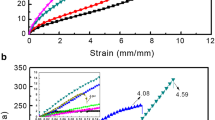Abstract
Hydrogel is a promising soft matter attracting intensive study in the field of biomaterial, flexible electronics and soft robotics. The creation of a crosslinking polymer network is vital in fabricating hydrogel. A new method of fabrication brings more choices to the field. In this work, we show that the freezing–thawing method can be applied to prepare high-performance calcium–polyacrylic acid hydrogel. We polymerize acrylic acid in calcium chloride solution and obtain a soft and weak hydrogel; after the freezing–thawing treatment, the performance of the hydrogel improves profoundly. The freeze–thawed hydrogel can sustain strain up to 1100% and fracture at a stress of 0.6 MPa. This hydrogel also shows low hysteresis less than 5% at 200% strain and good recovery up to 800% strain. The hydrogel is strengthened by the increase of ionic bonds between cation and polymer chain during the freezing treatment. The same strategy can be applied to increase the inter-chain interaction of other hydrogels and thus provides more possibility in the design of hydrogel network.








Similar content being viewed by others
References
Ahmed EM (2015) Hydrogel: Preparation, characterization, and applications: a review. J Adv Res 6(2):105–121. https://doi.org/10.1016/j.jare.2013.07.006
Gong JP, Katsuyama Y, Kurokawa T, Osada Y (2003) Double-network hydrogels with extremely high mechanical strength. Adv Mater 15(14):1155–1158
Wallin TJ, Pikul J, Shepherd RF (2018) 3D printing of soft robotic systems. Nat Rev Mater 3(6):84–100. https://doi.org/10.1038/s41578-018-0002-2
Kweon OY, Samanta SK, Won Y, Yoo JH, Oh JH (2019) Stretchable and self-healable conductive hydrogels for wearable multimodal touch sensors with thermoresponsive behavior. ACS Appl Mater Interfaces 11(29):26134–26143. https://doi.org/10.1021/acsami.9b04440
Yang NN, Qi P, Ren J, Yu HP, Liu SX, Li J, Chen WS, Kaplan DL, Ling SJ (2019) Polyvinyl alcohol/silk fibroin/borax hydrogel lonotronics: a highly stretchable, self-healable, and biocompatible sensing platform. ACS Appl Mater Interfaces 11(26):23632–23638. https://doi.org/10.1021/acsami.9b06920
Gong JP (2010) Why are double network hydrogels so tough? Soft Matter 6(12):2583–2590. https://doi.org/10.1039/b924290b
Chen Q, Chen H, Zhu L, Zheng J (2016) Engineering of tough double network hydrogels. Macromol Chem Phys 217(9):1022–1036. https://doi.org/10.1002/macp.201600038
Wang W, Zhang YY, Liu WG (2017) Bioinspired fabrication of high strength hydrogels from non-covalent interactions. Prog Polym Sci 71:1–25. https://doi.org/10.1016/j.progpolymsci.2017.04.001
Stauffer SR, Peppas NA (1992) Poly(vinyl alcohol) hydrogels prepared by freezing–thawing cyclic processing. Polymer 33(18):3932–3936. https://doi.org/10.1016/0032-3861(92)90385-a
Zhang HJ, Xia HS, Zhao Y (2012) Poly(vinyl alcohol) hydrogel can autonomously self-heal. ACS Macro Lett 1(11):1233–1236. https://doi.org/10.1021/mz300451r
Huang HB, Yao JL, Li L, Zhu F, Liu ZT, Zeng XP, Yu XH, Huang ZL (2016) Reinforced polyaniline/polyvinyl alcohol conducting hydrogel from a freezing–thawing method as self-supported electrode for supercapacitors. J Mater Sci 51(18):8728–8736. https://doi.org/10.1007/s10853-016-0137-8
Gong ZY, Zhang GP, Zeng XL, Li JH, Li G, Huang WP, Sun R, Wong CP (2016) High-strength, tough, fatigue resistant, and self-healing hydrogel based on dual physically cross-linked network. ACS Appl Mater Interfaces 8(36):24030–24037. https://doi.org/10.1021/acsami.6b05627
Khaleghi M, Mani F, Salimi H, Hajibeygi M, Pashazadeh R, Zayerzadeh E, Babanejad N, Shabanian M (2018) Synthesis and characterization of new honey incorporated double-network hydrogels based on poly(vinyl alcohol) and acylated chitosan. Adv Polym Technol 37(8):3596–3606. https://doi.org/10.1002/adv.22144
Li G, Zhang H, Fortin D, Xia H, Zhao Y (2015) Poly(vinyl alcohol)-poly(ethylene glycol) double-network hydrogel: a general approach to shape memory and self-healing functionalities. Langmuir 31(42):11709–11716. https://doi.org/10.1021/acs.langmuir.5b03474
Zhang Y, Song M, Diao Y, Li B, Shi L, Ran R (2016) Preparation and properties of polyacrylamide/polyvinyl alcohol physical double network hydrogel. RSC Adv 6(113):112468–112476. https://doi.org/10.1039/c6ra24006b
Sabzi M, Samadi N, Abbasi F, Mandavinia GR, Babaahmadi M (2017) Bioinspired fully physically cross-linked double network hydrogels with a robust, tough and self-healing structure. Mater Sci Eng C Mater Biol Appl 74:374–381. https://doi.org/10.1016/j.msec.2016.12.026
Lai J, Zhou H, Wang M, Chen Y, Jin Z, Li S, Yang J, Jin X, Liu H, Zhao W (2018) Recyclable, stretchable and conductive double network hydrogels towards flexible strain sensors. J Mater Chem C 6(48):13316–13324. https://doi.org/10.1039/c8tc04958k
Deville S (2013) Ice-templating, freeze casting: beyond materials processing. J Mater Res 28(17):2202–2219. https://doi.org/10.1557/jmr.2013.105
Cheng Q, Huang C, Tomsia AP (2017) Freeze casting for assembling bioinspired structural materials. Adv Mater. https://doi.org/10.1002/adma.201703155
Hassan CM, Peppas NA (2000) Structure and morphology of freeze/thawed PVA hydrogels. Macromolecules 33(7):2472–2479. https://doi.org/10.1021/ma9907587
Acknowledgements
Dr. Yunming Li would like to thank the financial support by the Science and Technology Project of Educational Commission of Jiangxi Province, China (GJJ161198).
Author information
Authors and Affiliations
Corresponding authors
Ethics declarations
Conflict of interest
The authors declare that they have no conflict of interest.
Additional information
Publisher's Note
Springer Nature remains neutral with regard to jurisdictional claims in published maps and institutional affiliations.
Electronic supplementary material
Below is the link to the electronic supplementary material.
Rights and permissions
About this article
Cite this article
Cao, C., Li, Y. Highly stretchable calcium ion/polyacrylic acid hydrogel prepared by freezing–thawing. J Mater Sci 55, 5340–5348 (2020). https://doi.org/10.1007/s10853-019-04332-8
Received:
Accepted:
Published:
Issue Date:
DOI: https://doi.org/10.1007/s10853-019-04332-8




